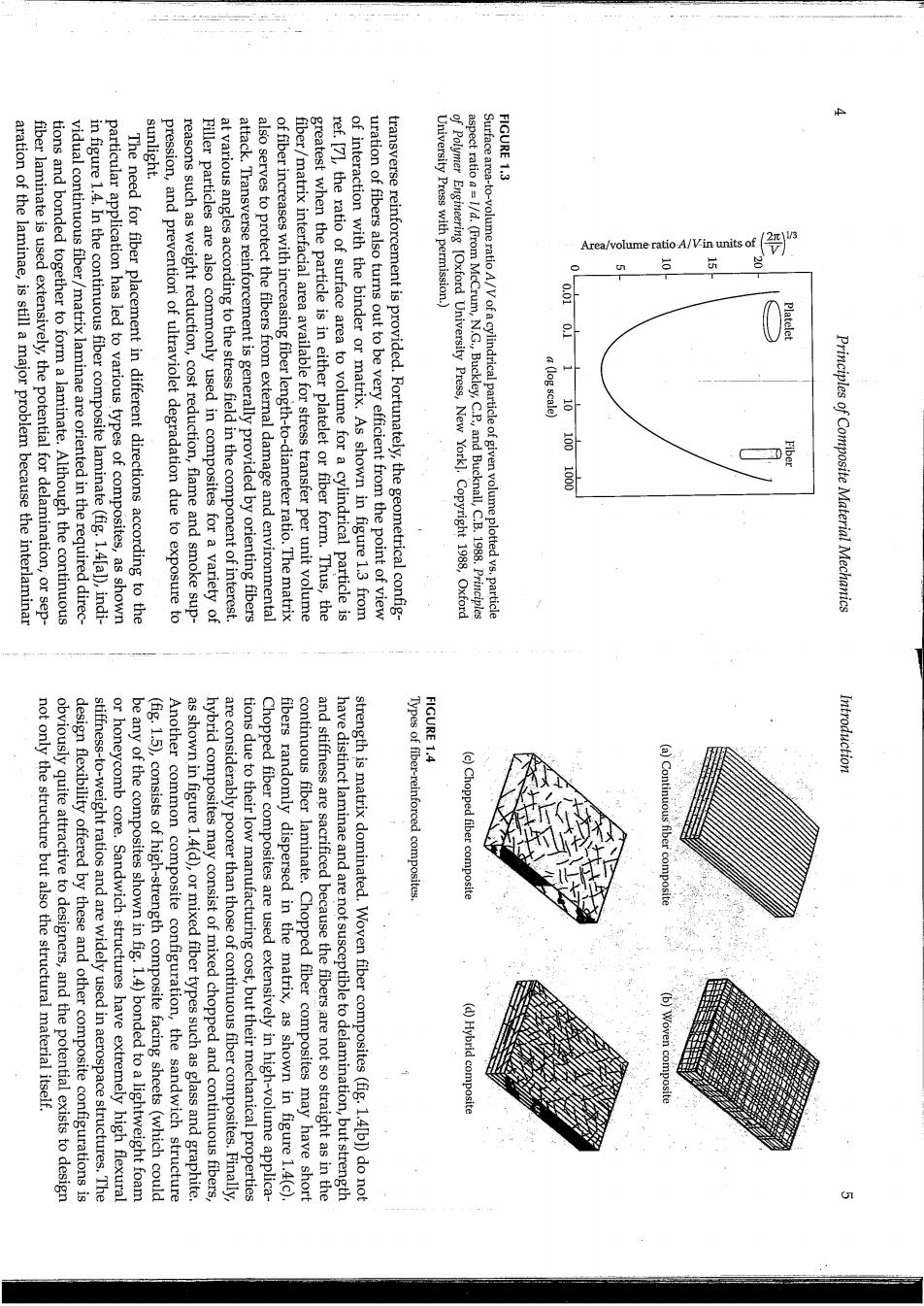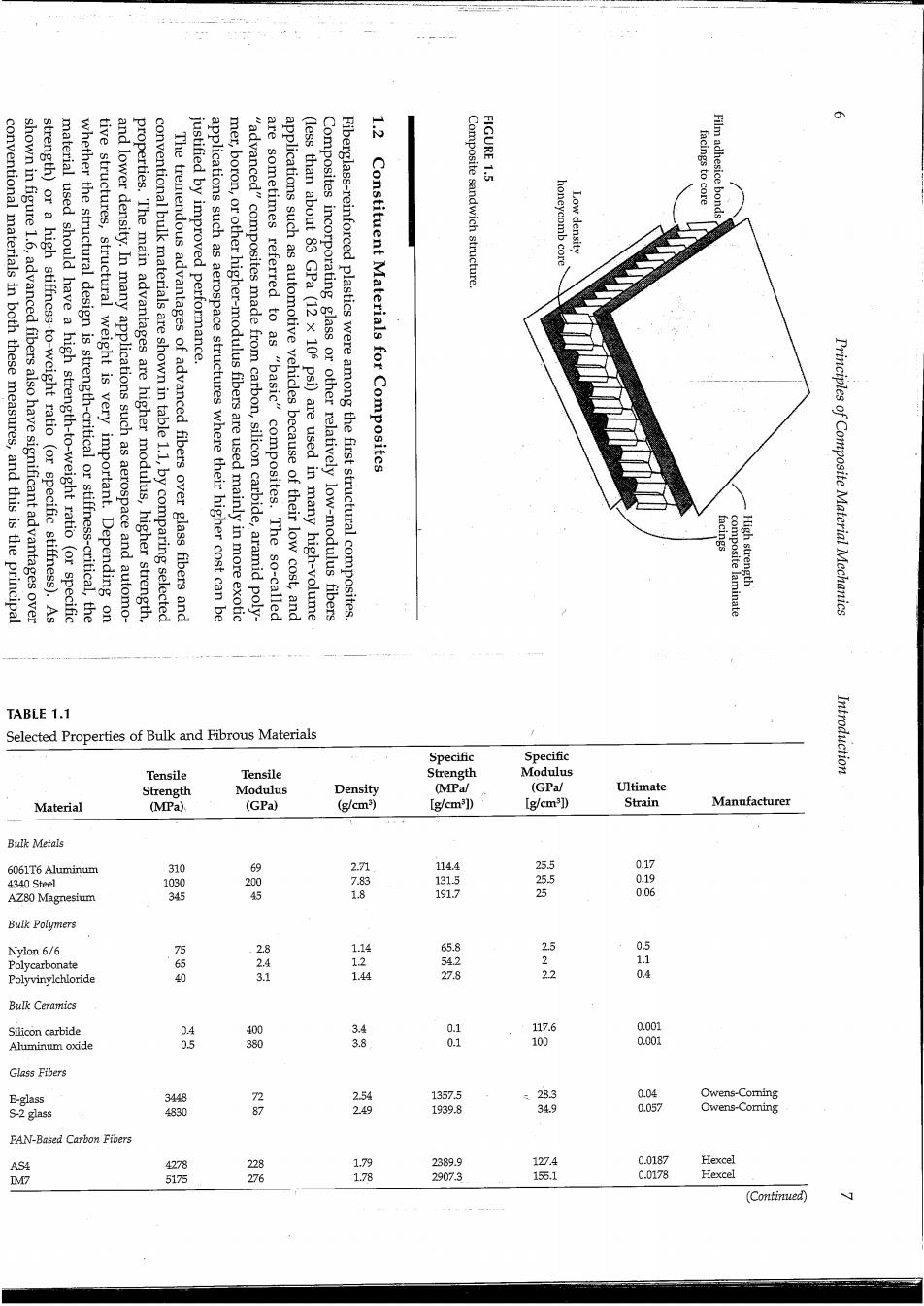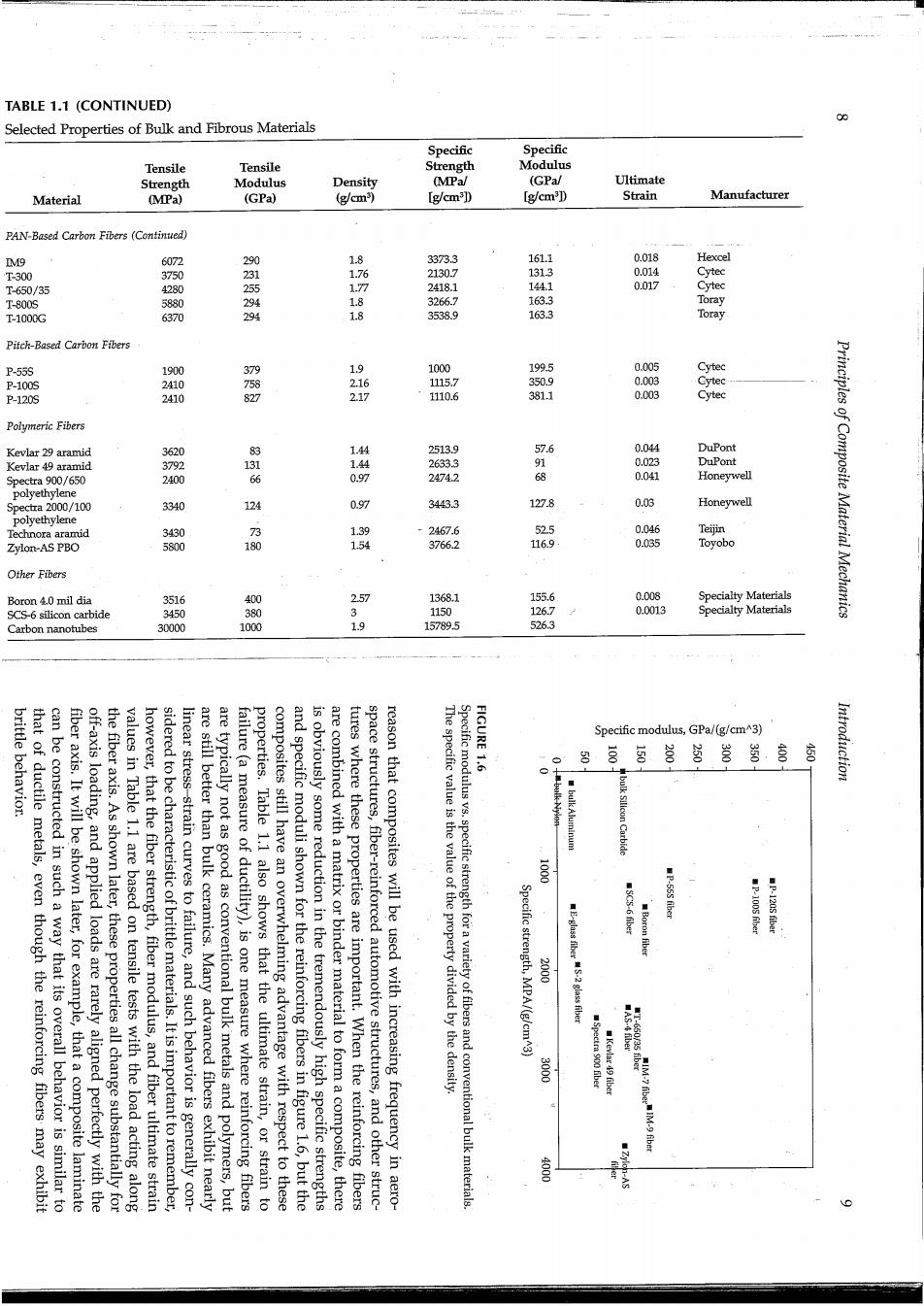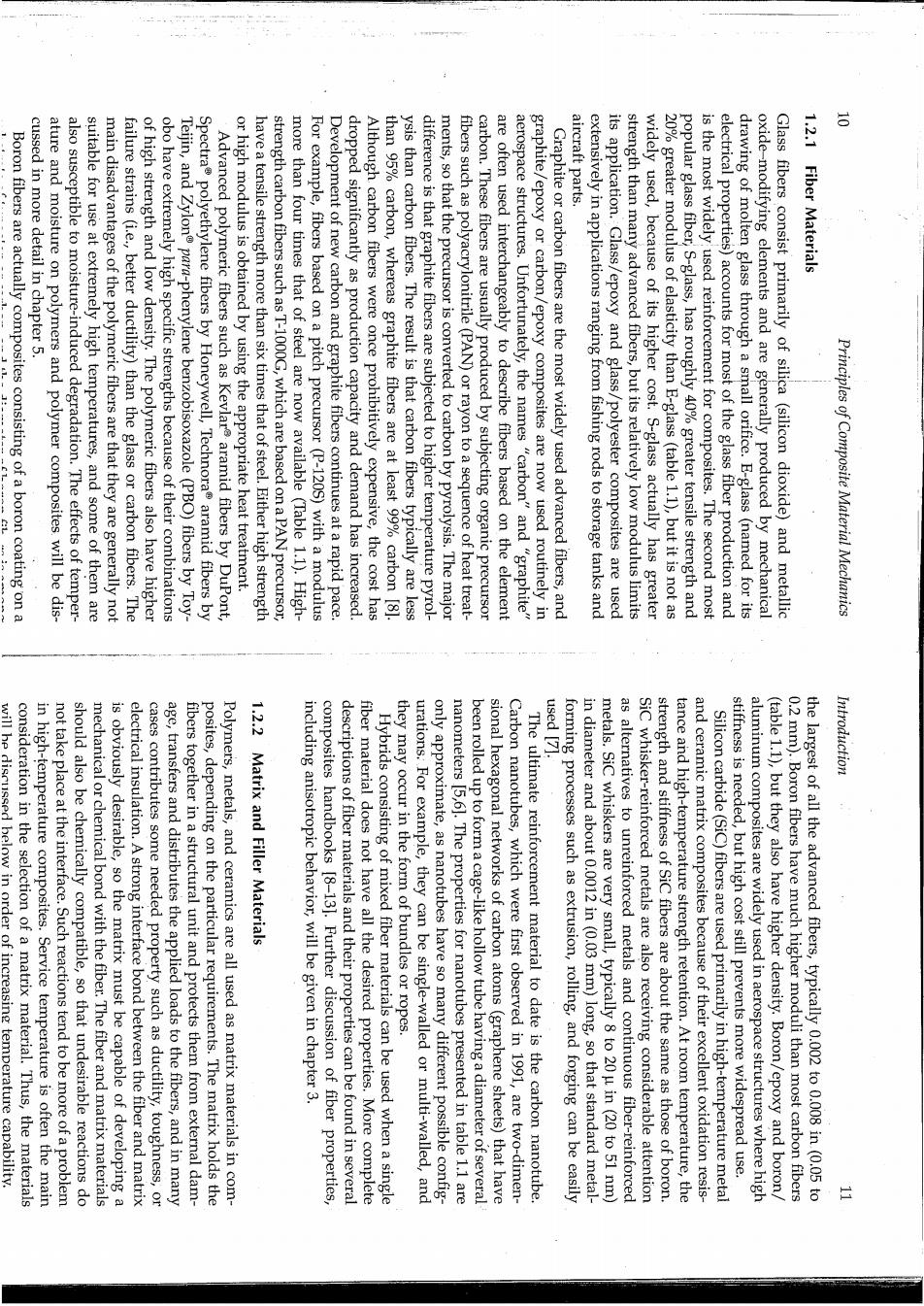
sunlight. FIGURE 1.3 aration of the laminae,is still a major problem because the interlaminar fiber laminate is used extensively,the potential for delamination,or sep- tions and bonded together to form a laminate.Although the continuous vidual continuous fiber/matrix laminae are oriented in the required direc- in figure 1.4.In the continuous fiber composite laminate(fig.1.4[al),indi- particular application has led to various types of composites,as shown The need for fiber placement in different directions according to the pression,and prevention of ultraviolet degradation due to exposure to reasons such as weight reduction,cost reduction,flame and smoke sup- Filler particles are also commonly used in composites for a variety of at various angles according to the stress field in the component of interest. attack.Transverse reinforcement is generally provided by orienting fibers also serves to protect the fibers from external damage and environmental of fiber increases with increasing fiber length-to-diameter ratio.The matrix fiber/matrix interfacial area available for stress transfer per unit volume greatest when the particle is in either platelet or fiber form.Thus,the ref.[7],the ratio of surface area to volume for a cylindrical particle is of interaction with the binder or matrix.As shown in figure 1.3 from uration of fibers also turns out to be very efficient from the point of view transverse reinforcement is provided.Fortunately,the geometrical config- University Press with permission.) aspect ratio=1/d.(From McCrum,N.G.Buckley,C.P,and Bucknall,C.B.1988.Principles of Polymer Engineering [Oxford University Press,New York].Copyright 1988,Oxford Surface area-to-volume ratio A/Vof a cylindrical particle of given volume plotted vs.particle Area/volume ratio A/Vin units of 13 0.01 a (log scale) 10 1001000 Fiber Principles of Composite Material Mechanics FIGURE 1.4 not only the structure but also the structural material itself. (a)Contint Introduction obviously quite attractive to designers,and the potential exists to design design flexibility offered by these and other composite configurations is stiffness-to-weight ratios and are widely used in aerospace structures.The or honeycomb core.Sandwich structures have extremely high flexural be any of the composites shown in fig.1.4)bonded to a lightweight foam (fig.1.5),consists of high-strength composite facing sheets(which could Another common composite configuration,the sandwich structure as shown in figure 1.4(d),or mixed fiber types such as glass and graphite. hybrid composites may consist of mixed chopped and continuous fibers, are considerably poorer than those of continuous fiber composites.Finally, tions due to their low manufacturing cost,but their mechanical properties Chopped fiber composites are used extensively in high-volume applica- fibers randomly dispersed in the matrix,as shown in figure 1.4(c). continuous fiber laminate.Chopped fiber composites may have short and stiffness are sacrificed because the fibers are not so straight as in the have distinct laminae and are not susceptible to delamination,but strength strength is matrix dominated.Woven fiber composites(fig.1.4[b])do not Types of fiber-reinforced composites. (c)Chopped fiber composite (d)Hybrid composite

2 FIGURE 1.5 facings to core Film adhesice bonds conventional materials in both these measures,and this is the principal shown in figure 1.6,advanced fibers also have significant advantages over strength)or a high stiffness-to-weight ratio (or specific stiffness).As material used should have a high strength-to-weight ratio (or specific whether the structural design is strength-critical or stiffness-critical,the tive structures,structural weight is very important.Depending on and lower density.In many applications such as aerospace and automo- properties.The main advantages are higher modulus,higher strength, conventional bulk materials are shown in table 1.1,by comparing selected The tremendous advantages of advanced fibers over glass fibers and justified by improved performance. applications such as aerospace structures where their higher cost can be mer,boron,or other higher-modulus fibers are used mainly in more exotic "advanced"composites made from carbon,silicon carbide,aramid poly- are sometimes referred to as "basic"composites.The so-called applications such as automotive vehicles because of their low cost,and (less than about 83 GPa(12 x 106 psi)are used in many high-volume Composites incorporating glass or other relatively low-modulus fibers Fiberglass-reinforced plastics were among the first structural composites Constituent Materials for Composites Composite sandwich structure. honeycomb core Low density facin composite laminate High strength Principles of Composite Material Mechanics TABLE 1.1 Selected Properties of Bulk and Fibrous Materials Specific Specific Introduction Tensile Tensile Strength Modulus Strength Modulus Density (MPa/ (GPa/ Ultimate Material (MPa) (GPa) (g/cm) [g/cm1) [g/cmJ) Strain Manufacturer Bulk Metals 6061T6 Aluminum 310 114.4 25.5 0.17 4340 Steel 1030 131.5 AZ80 Magnesium 345 45 1.8 191.7 826 Bulk Polymers Nylon 6/6 332433 65.8 13222 0 Polycarbonate 542 Polyvinylchloride 1.4 27.8 04 Bulk Ceramics Silicon carbide Aluminum oxide 8 38 36 81 117.6 0.001 100 0.001 Glass Fibers E-glass 3448 1357.5 28.3 0.04 Owens-Comning S-2glass 4830 2附 1939.8 34.9 0.05 Owens-Coming PAN-Based Carbon Fibers 4278 228 1.79 2389.9 127.4 0.0187 Hexcel 5173 276 1.78 2907.3 155.1 0.0178 Hexcel (Continued)

TABLE 1.1 (CONTINUED) Selected Properties of Bulk and Fibrous Materials Specific Specific Tensile Tensile Strength Modulus Strength Modulus Density (MPa/ (GPa/ Ultimate Material (MPa) (GPa) (g/cm) [g/cmD) [g/cmD Strain Manufacturer PAN-Based Carbon Fibers (Continued) IM 6072 1.8 3373.3 161.1 0.018 Hexcel T300 3750 2130.7 1313 0.014 Cytec T-650/35 4280 2418.1 144.1 0.017 Cytec T-800S 5880 奶1切1818 3266.7 163.3 T-1000G 6370 3538.9 163.3 Pitch-Based Carbon Fibers P-55S P-100S 288 P-120S 2410 器 1.9 1000 19.5 0.05 Cytec 6 1115.7 350.9 0.003 Cytec 1110.6 381.1 0.003 Cytec Polymeric Fibers Kevlar 29 aramid 3620 2513.9 Kevlar 49 aramid 3792 进 2633.3 8 DuPont DuPont Spectra 900/650 2400 2474.2 0.041 Honeywell polyethylene Spec女a2000/100 3340 124 0.97 3443.3 127.8 0.03 Honeywell polyethylene Technora aramid 3430 2467.6 Zylon-AS PBO 5800 13双 3766.2 tig 0.046 Teijin 0.035 Toyobo Principles of Composite Material Mechanics Other Fibers Boron 4.0 mil dia 3516 400 57 1368.1 155.6 0.008 Specialty Materials SCS-6 silicon carbide 3450 380 3 1150 126.7 0.0013 Specialty Materials Carbon nanotubes 30000 1000 . 15789.5 526.3 brittle behavior. FIGURE 1.6 Specific modulus,GPa/(g/cm^3) 0、 % 营 营 Introduction that of ductile metals,even though the reinforcing fibers may exhibit can be constructed in such a way that its overall behavior is similar to fiber axis.It will be shown later,for example,that a composite laminate off-axis loading,and applied loads are rarely aligned perfectly with the the fiber axis.As shown later,these properties all change substantially for values in Table 1.1 are based on tensile tests with the load acting along however,that the fiber strength,fiber modulus,and fiber ultimate strain sidered to be characteristic of brittle materials.It is important to remember, linear stress-strain curves to failure,and such behavior is generally con- are still better than bulk ceramics.Many advanced fibers exhibit nearly are typically not as good as conventional bulk metals and polymers,but failure(a measure of ductility),is one measure where reinforcing fibers properties.Table 1.1 also shows that the ultimate strain,or strain to composites still have an overwhelming advantage with respect to these and specific moduli shown for the reinforcing fibers in figure 1.6,but the is obviously some reduction in the tremendously high specific strengths are combined with a matrix or binder material to form a composite,there tures where these properties are important.When the reinforcing fibers space structures,fiber-reinforced automotive structures,and other struc- reason that composites will be used with increasing frequency in aero- The specific value is the value of the property divided by the density. Specific modulus vs.specific strength for a variety of fibers and conventional bulk materials. bulk Nylon bid Specific strength,MPA/(g/cm^3) SCS-6 fiber P-55S fiber Boron fiber PP-1000h5c5 P-120S fiber 2000 8000 Kevlar 49 fiber 000 Zylon-AS

Boron fibers are actually composites consisting of a boron coating on a cussed in more detail in chapter 5. aircraft parts. ature and moisture on polymers and polymer composites will be dis- also susceptible to moisture-induced degradation.The effects of temper- suitable for use at extremely high temperatures,and some of them are main disadvantages of the polymeric fibers are that they are generally not failure strains (i.e.,better ductility)than the glass or carbon fibers.The of high strength and low density.The polymeric fibers also have higher obo have extremely high specific strengths because of their combinations Teijin,and Zylon para-phenylene benzobisoxazole (PBO)fibers by Toy- Spectra polyethylene fibers by Honeywell,Technora aramid fibers by Advanced polymeric fibers such as Kevlar aramid fibers by DuPont, or high modulus is obtained by using the appropriate heat treatment. have a tensile strength more than six times that of steel.Either high strength strength carbon fibers such as T-1000G,which are based on a PAN precursor, more than four times that of steel are now available (Table 1.1).High- For example,fibers based on a pitch precursor(P-120S)with a modulus Development of new carbon and graphite fibers continues at a rapid pace dropped significantly as production capacity and demand has increased Although.carbon fibers were once prohibitively expensive,the cost has than 95%carbon,whereas graphite fibers are at least 99%carbon [8] ysis than carbon fibers.The result is that carbon fibers typically are less difference is that graphite fibers are subjected to higher temperature pyrol- ments,so that the precursor is converted to carbon by pyrolysis.The major fibers such as polyacrylonitrile(PAN)or rayon to a sequence of heat treat- carbon.These fibers are usually produced by subjecting organic precursor are often used interchangeably to describe fibers based on the element aerospace structures.Unfortunately,the names "carbon"and "graphite" graphite/epoxy or carbon/epoxy composites are now used routinely in Graphite or carbon fibers are the most widely used advanced fibers,and extensively in applications ranging from fishing rods to storage tanks and its application.Glass/epoxy and glass/polyester composites are used strength than many advanced fibers,but its relatively low modulus limits widely used,because of its higher cost.S-glass actually has greater 20%greater modulus of elasticity than E-glass(table 1.1),but it is not as popular glass fiber S-glass,has roughly 40%greater tensile strength and is the most widely used reinforcement for composites.The second most electrical properties)accounts for most of the glass fiber production and drawing of molten glass through a small orifice.E-glass (named for its oxide-modifying elements and are generally produced by mechanical Glass fibers consist primarily of silica (silicon dioxide)and metallic Fiber Materials Principles of Composite Material Mechanics Introduction will he discussed below in order of increasing temperature capability. consideration in the selection of a matrix material.Thus,the materials in high-temperature composites.Service temperature is often the main not take place at the interface.Such reactions tend to be more of a problem should also be chemically compatible,so that undesirable reactions do mechanical or chemical bond with the fiber.The fiber and matrix materials is obviously desirable,so the matrix must be capable of developing a electrical insulation.A strong interface bond between the fiber and matrix cases contributes some needed property such as ductility,toughness,or age,transfers and distributes the applied loads to the fibers,and in many fibers together in a structural unit and protects them from external dam- posites,depending on the particular requirements.The matrix holds the Polymers,metals,and ceramics are all used as matrix materials in com- 1.2.2 Matrix and Filler Materials including anisotropic behavior,will be given in chapter 3. composites handbooks [8-13].Further discussion of fiber properties, descriptions of fiber materials and their properties can be found in several fiber material does not have all the desired properties.More complete Hybrids consisting of mixed fiber materials can be used when a single they may occur in the form of bundles or ropes. urations.For example,they can be single-walled or multi-walled,and only approximate,as nanotubes have so many different possible config- nanometers [5,6].The properties for nanotubes presented in table 1.1 are been rolled up to form a cage-like hollow tube having a diameter of several sional hexagonal networks of carbon atoms (graphene sheets)that have Carbon nanotubes,which were first observed in 1991,are two-dimen- The ultimate reinforcement material to date is the carbon nanotube. forming processes such as extrusion,rolling,and forging can be easily in diameter and about 0.0012 in(0.03 mm)long,so that standard metal- metals.SiC whiskers are very small,typically 8 to 20 j in (20 to 51 nm) as alternatives to unreinforced metals and continuous fiber-reinforced SiC whisker-reinforced metals are also receiving considerable attention strength and stiffness of SiC fibers are about the same as those of boron. tance and high-temperature strength retention.At room temperature,the and ceramic matrix composites because of their excellent oxidation resis- Silicon carbide(SiC)fibers are used primarily in high-temperature metal stiffness is needed,but high cost still prevents more widespread use. aluminum composites are widely used in aerospace structures where high (table 1.1),but they also have higher density.Boron/epoxy and boron/ 0.2 mm).Boron fibers have much higher moduli than most carbon fibers the largest of all the advanced fibers,typically 0.002 to 0.008 in (0.05 to

in composites. cooling. [11].Fillers truly add another dimension to the design flexibility we have ation,and alumina trihydrate is used for flame and smoke suppression cost,carbon black particles are used for protection against ultraviolet radi- spheres are used to reduce weight,clay or mica particles are used to reduce some other aspect of composite behavior.For example,hollow glass micro- used to improve mechanical properties but,rather,are used to enhance in with the matrix material during fabrication.Fillers are not generally The third constituent material of a composite,the filler material,is mixed erties for typical matrix materials will be given. [8-13].Matrix properties will be discussed again in chapter 3,where prop- and their properties,the reader is referred to any of several handbooks a few critical aerospace applications.For further details on matrix materials (5000F),but the cost of these materials is such that they are used only in matrix composites can be used at temperatures approaching 2760C before these materials can be routinely used.Finally,carbon fiber/carbon and are notoriously brittle,however,and there is a need for much research temperatures up to 1650C(3000F).Ceramics have poor tensile strength matrix materials such as silicon carbide and silicon nitride can be used at and ductility than polymers but at the expense of higher density.Ceramic (2280F).Other advantages of metal matrices are higher strength,stiffness nickel aluminide,operating temperatures can be extended to about 1250C sium and their alloys and intermetallics such as titanium aluminide and By using lightweight metals such as aluminum,titanium,and magne- matrix materials are required. (800F)are feasible.For higher temperatures,metal,ceramic,or carbon At this time,it appears that polymer matrix materials for use up to 425C PEEK have melting temperatures in the range 315 to 370C(600 to 700F) above 150C(300F),whereas advanced thermoplastics such as PPS,PI,and cured at about 177C(350F)and are generally not used at temperatures their higher-temperature capabilities.Aerospace grade epoxies are typically low moisture absorption properties,their simple processing cycles,and are now receiving considerable attention for their excellent toughness and for several decades,but advanced thermoplastics such as PEEK and PPS Epoxies and polyesters have been the principal polymer matrix materials tics will soften and melt at high temperatures,then harden again upon are based on polymer chains that do not cross-link.As a result,thermoplas- network that does not melt at high temperatures.Thermoplastics,however, curing,thermosets form a highly cross-linked,three-dimensional molecular fone,polyetheretherketone [PEEK],polyphenylene sulfide.[PPS]).Upon epoxy,polyester,phenolic)or thermoplastics (e.g.,polyimide [PII,polysul- modern composites.Polymers are described as being either thermosets(e.g., Polymers are unquestionably the most widely used matrix materials in Principles of Composite Material Mechanics FIGURE 1.7 tures for Aerospace Vehicles.NASA TM-2001-210844.) Introduction An Assessment of the State-of-the-Art in the Design and Manufacturing of Large Composite Struc Lockheed Martin F-22 Raptor.(From Harris,C.E.,Starnes,J.H.,Jr.,and Shuart,M.J.2001 aircraft in recent years is shown graphically in figure 1.8.Not shown in The steady growth in the use of composite structures in military fighter been used in fighter aircraft such as the F-14,F-15,F-16,...,F-22 (fig.1.7). vertical stabilizers,flaps,wing skins,and various control surfaces have accelerated quickly.Composite structural elements such as horizontal and early 1960s,applications of advanced composites in military aircraft have reduce drag.Since boron and graphite fibers were first developed in the faces (no rivets or sharp transitions as in metallic construction),which so heavily on weight.Composite construction also leads to smooth sur- stiffness,since performance and maneuverability of those vehicles depend dous potential of composites with high specific strength and high specific Military aircraft designers were among the first to realize the tremen- cations,it is appropriate to begin this brief overview there. much of the current composites technology evolved from aerospace appli- to consumer products such as skis,golf clubs,and tennis rackets.Since for automotive,aerospace,marine,and architectural structures in addition Composite structural elements are now used in a variety of components Structural Applications of Composites